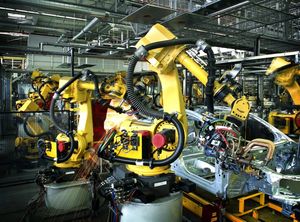
NVIDIA (NASDAQ: NVDA) continues to be the undisputed titan in the artificial intelligence arena, recently unveiling a dazzling Q2 fiscal year 2026 earnings report that underscored its foundational role in the global AI revolution. The company reported a remarkable 56% year-over-year surge in its Data Center revenue, propelling overall revenue to an impressive $46.7 billion. While these figures paint a picture of extraordinary growth and market leadership, the report also exposed the immense investor expectations surrounding NVIDIA, as its stock experienced a "perfection tax," retreating slightly in after-hours trading despite exceeding analyst forecasts.
This dual narrative of unparalleled success juxtaposed with heightened market scrutiny highlights the pivotal moment NVIDIA finds itself in. Its innovations are not just driving its own profitability but are also powering the generative AI boom, influencing everything from cloud computing infrastructure to advanced industrial applications. The immediate implications for the market are clear: NVIDIA remains the benchmark for AI hardware, yet even its phenomenal performance is now measured against an ever-escalating bar, signaling both confidence and caution in the red-hot AI sector.
NVIDIA's Q2 Triumph: Why the Data Center's Surge is a Game-Changer
NVIDIA's second quarter of fiscal year 2026, ending July 27, 2025, was nothing short of monumental, showcasing the company's deepening entrenchment in the foundational infrastructure of artificial intelligence. Total revenue soared to an astounding $46.7 billion, representing a robust 56% increase from the prior year and a solid 6% sequential growth. This financial powerhouse generated a GAAP net income of $26.4 billion, a staggering 59% jump year-over-year, translating to a GAAP diluted earnings per share (EPS) of $1.08.
The true engine behind this phenomenal performance was the Data Center segment, which alone accounted for a dominant 88-89% of NVIDIA's total revenue, reaching an impressive $41.1 billion. This segment's 56% year-over-year and 5% sequential growth was largely fueled by the burgeoning adoption of NVIDIA's next-generation Blackwell platform. Hyperscale cloud providers, including giants like Microsoft (NASDAQ: MSFT), Google (NASDAQ: GOOGL), and Amazon (NASDAQ: AMZN), are rapidly integrating Blackwell-powered solutions into their infrastructure, affirming NVIDIA's indispensable role in scaling AI capabilities. CEO Jensen Huang noted the "extraordinary" demand for Blackwell Ultra, with production ramping at full speed, indicating a strong pipeline for future growth. The NVIDIA RTX PRO™ 6000 Blackwell Server Edition GPU is already seeing widespread adoption across diverse industries, with enterprises such as Disney (NYSE: DIS), Foxconn, Hitachi Ltd. (TYO: 6501), Hyundai Motor Group, Lilly (NYSE: LLY), SAP (NYSE: SAP), and TSMC (NYSE: TSM) among the first to deploy these cutting-edge systems. Further enhancing its professional visualization offerings, NVIDIA also introduced new GPUs like the NVIDIA RTX PRO 4000 SFF Edition and RTX PRO 2000 Blackwell.
Beyond hardware, NVIDIA's strategic partnerships are expanding its ecosystem and market reach. A particularly significant collaboration highlighted in the earnings call was the expanded alliance with Siemens (FWB: SIE), aimed at revolutionizing industrial AI and accelerating the vision of the "manufacturing factory of the future." This partnership integrates NVIDIA's AI and accelerated computing prowess with Siemens' Xcelerator platform, leading to tangible innovations. For instance, Siemens has launched a new line of Industrial PCs certified for NVIDIA GPUs, designed for the rigors of factory environments. The synergy was further demonstrated by the BMW Group and Siemens achieving a 30x speedup in vehicle aerodynamics simulations using Simcenter Star-CCM+ software, accelerated by NVIDIA Blackwell and CUDA-X libraries. Siemens' upcoming Industrial Copilot for Operations, powered by NVIDIA RTX PRO 6000 Blackwell Server Edition GPUs, is projected to slash reactive maintenance time by 30%.
In a move to bolster shareholder confidence and return capital, NVIDIA's Board of Directors authorized an additional $60.0 billion for its share repurchase program, demonstrating robust financial health and a commitment to shareholder value. This follows $24.3 billion already returned in the first half of fiscal 2026 through buybacks and dividends. A quarterly cash dividend of $0.01 per share was also declared. Despite these overwhelmingly positive financial and strategic developments, the market reacted with a peculiar "perfection tax." NVIDIA's stock, though providing strong forward guidance for Q3 FY26 ($54.0 billion +/- 2% revenue and 73.5% non-GAAP gross margins), experienced an immediate retreat of over 2%, dipping as much as 5% in after-hours trading. This nuanced reaction stemmed from several factors: a perceived slowdown in the sequential growth of the Data Center segment (5% vs. previous double-digit ramps), persistent China headwinds (no H20 sales to China in Q2, U.S. export conditions including a 15% revenue share to the U.S. government, and reports of China urging firms against H20 purchases), and concerns over customer concentration, with two unnamed customers accounting for 39% of Q2 revenue. This intense scrutiny underscores NVIDIA's bellwether status in the AI sector, where every detail is magnified.
Winners and Losers in the AI Arms Race
NVIDIA's continued dominance in the AI chip market creates a clear delineation of winners and losers, reshaping strategic imperatives across the technology landscape. The most evident winners are the hyperscale cloud providers such as Microsoft (NASDAQ: MSFT), Google (NASDAQ: GOOGL), and Amazon (NASDAQ: AMZN). These companies rely heavily on NVIDIA's (NASDAQ: NVDA) powerful GPUs to build and scale their generative AI offerings, offering AI-as-a-service to a vast array of enterprises. Their substantial investments in NVIDIA's Blackwell platform ensure they remain at the forefront of AI innovation, attracting more customers to their cloud ecosystems. The deeper their integration with NVIDIA's technology, the more competitive their AI services become, driving demand and market share in the lucrative cloud computing sector.
Enterprise software and industrial automation companies forming strategic alliances with NVIDIA also stand to gain significantly. Siemens (FWB: SIE) is a prime example, leveraging NVIDIA's AI capabilities to transform industrial processes. By embedding NVIDIA's GPUs into its Industrial PCs and integrating AI across its Xcelerator platform, Siemens is not just enhancing its product offerings but also positioning itself as a leader in "industrial AI." This partnership opens up new revenue streams and competitive advantages, enabling Siemens to offer advanced solutions like AI-accelerated simulations and predictive maintenance, benefiting its vast client base which includes companies like BMW Group. Other early adopters of NVIDIA's cutting-edge technologies, like Disney (NYSE: DIS), Foxconn, Hitachi Ltd. (TYO: 6501), Hyundai Motor Group, Lilly (NYSE: LLY), SAP (NYSE: SAP), and TSMC (NYSE: TSM), are also poised to reap substantial benefits from improved efficiency, innovation, and accelerated product development.
Conversely, NVIDIA's direct competitors in the high-performance computing and AI chip space face an uphill battle. Companies like Advanced Micro Devices (NASDAQ: AMD) and Intel (NASDAQ: INTC), while making strides with their own AI accelerators, find it challenging to erode NVIDIA's deeply entrenched ecosystem, which benefits from years of developer loyalty to its CUDA platform. The "perfection tax" on NVIDIA, while seemingly negative, also highlights the immense gap in market leadership; a slight slowdown for NVIDIA is still a blistering pace for others. These competitors must invest heavily in R&D and strategic partnerships to develop compelling alternatives that can break through NVIDIA's formidable market share.
The broader hardware ecosystem, including server manufacturers and component suppliers, may experience a mixed impact. While increased demand for NVIDIA's GPUs drives sales of compatible servers and related infrastructure, NVIDIA's increasing integration into full-stack solutions could also lead to verticalization, potentially squeezing out certain niche players. Companies heavily reliant on older GPU architectures or those unable to adapt to the rapid pace of NVIDIA's innovation cycles might find themselves struggling to keep up, impacting their long-term viability and profitability.
Industry Impact and Broader Implications
NVIDIA's (NASDAQ: NVDA) sustained, explosive growth in its Data Center segment is not merely a corporate success story; it's a profound market signal that reinforces the AI revolution as the defining technological trend of our era. This performance firmly establishes NVIDIA as the primary architect of the computational infrastructure underpinning this revolution, from the training of foundational AI models to the deployment of complex generative AI applications across industries. The company's trajectory fits seamlessly into broader industry trends emphasizing accelerated computing, edge AI, and the relentless pursuit of more powerful and energy-efficient hardware to meet the insatiable demands of AI workloads.
The ripple effects on competitors and partners are significant. For direct rivals like Advanced Micro Devices (NASDAQ: AMD) and Intel (NASDAQ: INTC), NVIDIA's continued dominance underscores the imperative to accelerate their own AI hardware roadmaps and ecosystem development. While AMD's Instinct accelerators and Intel's Gaudi chips aim to challenge NVIDIA, the sheer scale of NVIDIA's deployments and its established CUDA software platform create a formidable barrier to entry and market share capture. This dynamic could compel competitors to explore specialized niches or even collaborate on open-source alternatives to compete more effectively. For partners, such as the major cloud providers (Microsoft (NASDAQ: MSFT), Google (NASDAQ: GOOGL), Amazon (NASDAQ: AMZN)), NVIDIA's advancements enable them to offer increasingly sophisticated AI services, fostering an ecosystem of innovation that benefits their own platforms. The expanded partnership with Siemens (FWB: SIE) exemplifies how NVIDIA's technology can permeate traditional industries, driving digital transformation and creating new market opportunities far beyond the data center.
Regulatory or policy implications are also becoming increasingly salient. The "perfection tax" and the detailed scrutiny of NVIDIA's sequential growth highlight concerns about market concentration in critical AI infrastructure. As AI becomes more ubiquitous and strategically vital, governments globally may start examining the implications of a single company holding such a dominant position in the supply chain. The U.S. government's conditions on H20 chip exports to China, including a revenue share, represent a direct intersection of geopolitical strategy and corporate performance, signaling potential future interventions or regulations impacting export controls and technology transfer. Historically, periods of rapid technological innovation and market concentration have often led to increased antitrust scrutiny or calls for greater competition, as seen with dominant players in the internet and software industries in previous decades.
This event also provides a historical parallel to the rise of other foundational technology providers, such as Intel in the PC era or Cisco (NASDAQ: CSCO) in the internet networking boom. Like these predecessors, NVIDIA is not just selling components; it's providing the core platform (hardware + CUDA software) that defines an entire technological paradigm. The rapid adoption of its Blackwell platform, similar to how previous generations of GPUs became standard, suggests a deepening moat around its market position. The sustained demand from a diverse set of industries – from automotive (Hyundai Motor Group) to pharmaceuticals (Lilly (NYSE: LLY)) and entertainment (Disney (NYSE: DIS)) – indicates that AI's impact is broad and not confined to a single sector, further solidifying NVIDIA's role as a cross-industry enabler.
What Comes Next: Navigating the Future of AI
NVIDIA's (NASDAQ: NVDA) commanding Q2 performance and its pivotal role in the AI landscape set the stage for a dynamic period of innovation and strategic maneuvering. In the short term, the market will closely watch the adoption rate of the Blackwell platform and its successor, Blackwell Ultra. The "extraordinary" demand cited by CEO Jensen Huang suggests strong revenue generation in the coming quarters, particularly from hyperscale cloud providers. However, the market's sensitivity to sequential growth rates means NVIDIA must consistently deliver, or exceed, these high expectations to maintain investor confidence and avoid further "perfection taxes." The success of the new RTX PRO GPUs will also be critical for expanding its footprint in professional visualization and enterprise workstations, diversifying its revenue streams beyond the core data center.
Longer term, NVIDIA's future growth trajectory will heavily depend on its ability to expand its ecosystem and penetrate new markets. The expanded partnership with Siemens (FWB: SIE) into industrial AI offers a blueprint for strategic pivots into sectors where AI can drive massive efficiencies, such as manufacturing, healthcare, and smart infrastructure. Developing tailored AI solutions and platforms for these vertical markets will be key. Furthermore, the company will likely continue to invest heavily in its software ecosystem, particularly CUDA, to maintain its competitive advantage and lock-in developers. Strategic acquisitions or investments in AI software companies could further enhance its full-stack AI offerings, making its platform even more indispensable.
Market opportunities or challenges that may emerge are numerous. The continued global demand for generative AI and large language models will provide a strong tailwind for NVIDIA's Data Center business. However, increasing competition from custom AI chips developed by cloud providers themselves (e.g., Google's TPUs, Amazon's Inferentia) and rival silicon from AMD (NASDAQ: AMD) and Intel (NASDAQ: INTC) poses a persistent challenge. Geopolitical tensions, particularly concerning U.S.-China tech relations and export controls, will remain a significant headwind, impacting potential revenue from key markets. The $2 billion to $5 billion in expected H20 revenue from China in Q3, contingent on export licenses and subject to a 15% revenue share to the U.S. government, illustrates the complexities NVIDIA must navigate.
Potential scenarios and outcomes for NVIDIA include a continued reign as the dominant AI chip provider, driving sustained high growth through successive generations of hardware and an expanding software ecosystem. Alternatively, increased competition and regulatory scrutiny could lead to a more fragmented market, potentially moderating NVIDIA's growth rate. The company's ability to innovate quickly, diversify its revenue streams, and adeptly manage geopolitical risks will determine its path forward. Investors should anticipate continued volatility as the market digests both NVIDIA's stellar performance and the inherent challenges of maintaining hyper-growth in such a critical and rapidly evolving sector.
Conclusion: NVIDIA's Enduring AI Mandate
NVIDIA's (NASDAQ: NVDA) Q2 fiscal 2026 earnings report serves as a powerful testament to its unrivaled position at the vanguard of the artificial intelligence revolution. The key takeaway is clear: NVIDIA is not merely participating in the AI boom; it is actively architecting its foundation, particularly through the explosive growth of its Data Center segment. The 56% year-over-year revenue surge in this crucial area, propelled by the adoption of its Blackwell platform and strategic partnerships with industry giants like Siemens (FWB: SIE), underscores the company's indispensable role in enabling the next generation of AI innovation. The substantial $60 billion share repurchase authorization signals robust financial health and a commitment to shareholder value, even amidst the market's demanding "perfection tax."
Moving forward, the market's assessment of NVIDIA will continue to be a blend of awe at its technological prowess and intense scrutiny over its growth trajectory. While the company's dominance in AI hardware is undisputed, concerns surrounding the sequential growth rate, geopolitical headwinds in China, and customer concentration risks highlight the challenges of sustaining hyper-growth in a highly competitive and evolving landscape. NVIDIA's ability to consistently deliver groundbreaking innovation, expand its ecosystem into new industrial verticals, and adeptly manage complex regulatory environments will be paramount to its long-term success.
The lasting impact of this period will likely be the reinforcement of NVIDIA's status as a foundational technology provider, akin to the titans of previous computing eras. Its full-stack approach, integrating cutting-edge hardware with the ubiquitous CUDA software platform, creates a powerful moat that will be difficult for competitors to breach. Investors should closely watch for continued advancements in the Blackwell platform, the success of new GPU lines like the RTX PRO series, and the expansion of its AI partnerships beyond traditional tech sectors. The company's management of supply chain dynamics and adaptation to evolving geopolitical trade policies, particularly concerning critical markets like China, will also be crucial indicators for its future performance in the months to come. Ultimately, NVIDIA's journey continues to be a bellwether for the entire AI industry, with its successes and challenges reflecting the broader dynamics of this transformative technological era.






